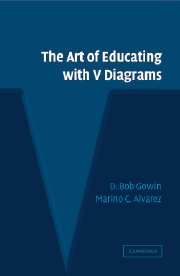Book contents
- Frontmatter
- Contents
- Foreword
- Preface
- Acknowledgment
- PART ONE FOUR COMMONPLACES OF EDUCATING PLUS ONE
- PART TWO THE V DIAGRAM
- 3 Thinking Around the V
- 4 Structuring Knowledge
- 5 Minding Events and Making a V
- 6 Learning and Teaching the V
- Part 2 Summary
- PART THREE ANALYZING, EVALUATING, AND CONDUCTING RESEARCH
- PART FOUR REASONING WITH TECHNOLOGY
- Part 4 Summary
- Epilogue
- Appendices
- Bibliography
- Name Index
- Subject Index
6 - Learning and Teaching the V
Published online by Cambridge University Press: 19 November 2009
- Frontmatter
- Contents
- Foreword
- Preface
- Acknowledgment
- PART ONE FOUR COMMONPLACES OF EDUCATING PLUS ONE
- PART TWO THE V DIAGRAM
- 3 Thinking Around the V
- 4 Structuring Knowledge
- 5 Minding Events and Making a V
- 6 Learning and Teaching the V
- Part 2 Summary
- PART THREE ANALYZING, EVALUATING, AND CONDUCTING RESEARCH
- PART FOUR REASONING WITH TECHNOLOGY
- Part 4 Summary
- Epilogue
- Appendices
- Bibliography
- Name Index
- Subject Index
Summary
Principle 6. TheVdiagram clarifies ambiguities and makes new events happen.
Teaching attempts to cultivate thought through shared meaning with the learner. The notion of this shared meaning is to arrive at reasoned judgments that can be agreed upon as either being accurate or making sense. However, while this fact or idea may meet a requisite requirement, it may be a stepping-stone to greater knowledge and meaning making once digested. Using the V to plan a lesson enables the teacher to think more deeply about the lesson for the learner that goes beyond mere “knowing” “understanding” and “application.” The V becomes an enabler for the teacher to construct a lesson that takes into consideration the various components arrayed on the V that lends itself to ensuring that careful planning has occurred. Likewise the V provides a structure for the learner to think about these components to stimulate creative thought that provides for manipulation of these thoughts during the course of the resolution.
Assemblage: A Prelude to Learning
A primary notion anticipating learning is assemblage consisting of exploring new ways of thinking without abandoning one's own experiences in the process (Whitehead, 1938). Before learning begins, we need to assemble materials in a very special manner. Assemblage denies systematic ways to arrive at predetermined outcomes at the expense of understanding and refutes repetition of the known. Instead assemblage demands sorting, manipulating, contrasting, comparing, trying-out, failing, and mindful thinking that is multidimensional in scope and includes the affective domain.
- Type
- Chapter
- Information
- The Art of Educating with V Diagrams , pp. 75 - 96Publisher: Cambridge University PressPrint publication year: 2005



